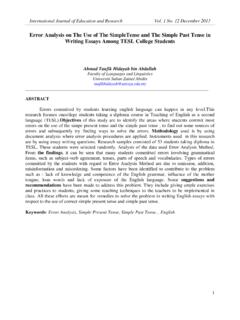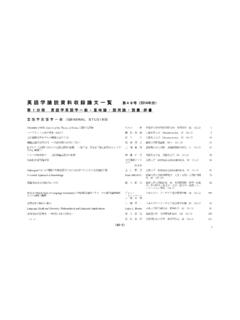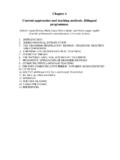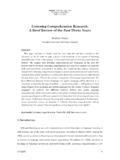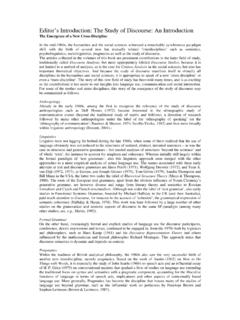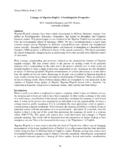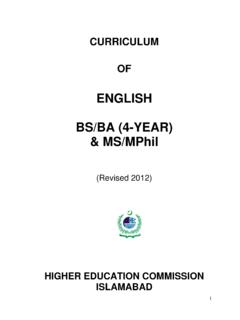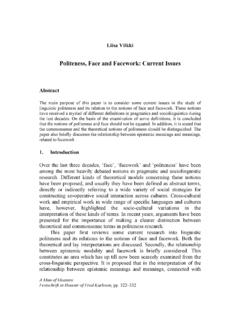Transcription of Sign Language Phonology Wendy Sandler - University of …
1 sign Language Phonology . Wendy Sandler . The University of appear in: The Oxford International Encyclopedia of Frawley, Language PhonologyWendy SandlerPhonology is more closely tied to the production and perceptionsystems than any other abstract level of linguistic structure. As signlanguages are transmitted in a different physical modality, the discoverythat they too have a Phonology has therefore been considered especiallysignificant. Stokoe (1960) demonstrated that the signs in the lexicon ofAmerican sign Language (ASL) are not holistic gestures, but are comprisedof a relatively small number of meaningless units that may recombine toproduce a potentially large lexicon. Since that pioneering work, otherresearchers have shown that these units are subject to constraints on theircombination, and are systematically altered in different phonological andmorphological contexts.
2 In addition to these shared generalcharacteristics, certain formal similarities between phonologies in the twomodalities have also emerged. Most is known about the Phonology of ASL;however, other sign languages, such as sign Language of the Netherlandsand Israeli sign Language , are being shown to have similar showed that features of handshape, location, and movementcan recombine to form minimal pairs of signs. For example, the signs DRY,UGLY and SUMMER in ASL are minimally distinguished by features oflocation. DRY UGLY SUMMERF igure 1. Minimal triplet in ASL, distinguished by features of location.(Reprinted with permission from Klima and Bellugi, 1979.)While early analyses emphasize the apparent simultaneity withwhich the formational elements are articulated, subsequent studies point tosignificant sequential properties (Liddell, 1984a; Sandler , 1989; Brentari,1998), and models have been developed to reflect this sequentiality (Liddelland Johnson, 1989; Sandler , 1989; Perlmutter, 1992; van der Hulst, 1993).
3 One of many examples of sequentiality is seen in the morphologicaloperation of verb agreement, which requires distinct reference to thebeginning and ending of the sign . 2 Figure 2. I GIVE YOU; S/HE GIVES ME reprinted with permission fromA Basic Course in American sign illustrations above show that on the surface, signs are typicallysequences of two locations with a movement in between. The number ofsequential units is limited, which contributes to the impression ofsimultaneity. Another reason for this impression is that key features ofthe most complex element, the handshape, generally remain constantthroughout a sign (Mandel, 1981).
4 To account for both sequential andsimultaneous properties, the theories of autosegmental Phonology (Goldsmith, 1976) and nonconcatenative morphology (McCarthy, 1979)have been adopted from spoken Language research. The handconfiguration class with long distance properties may be represented on aseparate tier, a representation that has explanatory consequences for otheraspects of the Phonology and morphology ( Sandler 1986, 1989).HCL M LFigure 3. Sequential Location and Movement segments and a HandConfiguration augosegment ( Sandler , 1989)This separation of the HC category from other categories facilitated thefurther development of hierarchical representations of articulator-basedfeature classes within the HC category (following Clements, 1985), whichcapture partial and total assimilation phenomena ( Sandler , 1987; Corina,1990a).
5 Various morphological operations require signs to conform to aprosodic template that may be partially prespecified (Liddell 1984b). Thistemplatic approach expresses formally the observation that themorphological complexity of sign Language words is in some sense simultaneous -- , nonconcatenative. For example, some ASL temporalaspect morphology changes the single straight movement path of a verb toa repeated circular one (Klima & Bellugi, 1979). This is analyzed asassociating a verbal root to an LML template with an arc featurepreassociated to the movement segment, and then reduplicating ( Sandler ,1989, 1990).Phonological and morphological rules interact in sign Language asin spoken Language . And, as in spoken Language , the lexical and postlexicalcomponents are distinct (Kiparsky, 1982).
6 In particular, it has been shownthat the output of phonological rules cannot undergo derivationalmorphological rules (Padden & Perlmutter, 1987).One sign Language phenomenon with no parallel in the spokenmodality is the existence of two anatomically identical potentialarticulators, the two hands. Despite this potential, and although both handsare involved in the formation of many signs, there is only one primary 3active articulator in lexical items (the dominant hand), as there is only oneprimary active articulator in spoken words (the tongue). Normally, withina word, the nondominant hand either copies what the dominant hand isdoing, or it does not articulate at all, serving as a place of articulation likethe head or trunk (Stokoe, 1960; Battison, 1978; Sandler , 1993a).
7 Abstractingaway from these two roles, the nondominant hand can be seen asessentially subordinate to the dominant hand regardless of its role(Brentari & Goldsmith, 1993). The tenets of the theory of dependencyphonology (Anderson and Ewen, 1987) allow direct representation of theparticular types of asymmetries that exist between the two hands: thedominant hand is represented as the head and the nondominant hand asthe dependent of the articulatory node of structure (van der Hulst, 1996).In addition to autosegmental structure, researchers have also foundevidence for suprasegmental structure. A principled distinction can bemade between a sign Language syllable spanning a single movement (or asimultaneous combination of path movement with handshape change ororientation change) and morphosyntactic units like morphemes or words(Brentari, 1990).
8 Several researchers suggest that movement represents akind of visual sonority (Brentari, 1990, 1998; Corina, 1990; Perlmutter, 1992; Sandler , 1993b). Arguing further that all dynamic elements form aphonological class, Brentari (1998) proposes a model of sign structure thatrepresents the sonorous elements distribution of various types of movement has been a key toolfor developing sonority scales and models of syllable structure. Perlmutter(1992) uses the distribution of secondary movement to support the claimthat there is a syllable peak which usually occurs on the movementelement of a sequentially organized syllable similar to the one pictured inFigure 3, in which the locations are compared to consonants andmovements to vowels.
9 Other researchers ( , Brentari, 1998) see sonorityas simultaneously realized over the whole syllable, and in this sense quitedifferent from its spoken Language work has looked to higher levels of prosody, investigatingthe phrasal Phonology of sign languages. sign Language utterances, likethose of spoken Language , are rhythmically chunked into units that haveregular prominence patterns and that partly correspond to syntacticconstituents (Wilbur, 1991, 1994, 1999; Nespor & Sandler , 1999; Sandler &Lillo-Martin, in preparation). It has even been suggested by theseresearchers that prosodic constituents carry intonational patterns of facialexpression. The pictures below show facial intonation, or superarticulation , in Israeli sign Language , conveying wh-questions(mainly furrowed brows), shared information (mainly squinted eyes), anda simultaneous combination of the two.
10 Although the prosodic domains forintonation appear to be the same as in spoken Language (Nespor & Sandler ,1999), such simultaneous componentiality is different from the sequentialnature of componential pitch excursions in spoken Language intonation(Pierrehumbert & Hirschberg, 1990). 4wh question superarticulation shared information superarticulationwh-question and shared information superarticulationFigure 4. Simultaneous componential intonation (superarticulation) inIsraeli sign Language (Reprinted with permission from Meir & Sandler , inpress)Research on sign Language Phonology leads to two conclusions,which are also important directions for future research in this relativelynew field: (1) there are universal properties of phonological organizationcommon to natural Language in radically different physical modalities, but(2) there are substantial areas in which the physical production andperception systems mold the Phonology of both modalities.
